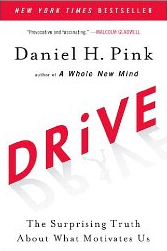Drive: Keeping a Child’s Love of Learning Alive

Every school we know talks about instilling a love of learning in children. But what does that actually mean?
Daniel Pink’s book Drive: The Surprising Truth About What Motivates Us highlights the importance of self-directed, autonomous learning, of learning that is aimed at getting better, at achieving mastery at tasks the child himself perceives as meaningful. The best learning makes the process of learning autotelic, meaning motivated by the pleasure of the experience itself. Children in such environments exhibit a sense of purpose and curiosity, they are fully engaged in what they do, they have, in the words of one scientist, many rewarding flow experiences.
Very young children naturally live in this state. Writes Pink:
A little kid’s life bursts with autotelic experience. Children careen from one flow moment to another, animated by a sense of joy, equipped with the mindset of possibility, and working with the dedication of a West Point cadet. They use their brains and their bodies to probe and draw feedback from the environment, in an endless pursuit of mastery.
Then, at some point in their lives, they don’t. What happened?
Our very mission as educators should be to not let “it” happen. Central to a sound educational approach is following the child, creating questions in his mind, enabling him to stay fascinated, engaged, to continue to want to learn because learning is inherently rewarding.
[Watch the video on the side for a fun comic-treatment on the difference between Montessori education and traditional schooling. It will make you laugh, and maybe cringe a little, too!]
Pink explains that three elements are essential to making this natural motivation happen.
- Autonomy, which means being curious and self-directed. In authentic Montessori preschool classrooms, autonomy is ever-present. Children choose what activity to work with: “Do I feel like figuring out the Trinomial Cube, or maybe the Metal Insets look fun today!” Children choose where to work: “Do I want to take out a mat to work on the floor, or curl up with a book on a bean bag in the corner?” Children choose with whom to work, including whether they’d like to work with anybody at all or by themselves.
- Purpose, which means doing something that is personally meaningful. In an Elementary and Junior High program, this means that students are motivated at root not by extrinsic rewards (stickers, grades, ice crème parties), but because they find the content they learn personally relevant to their own lives. Educating purposefully means teaching science so it helps the child understand his world and derive pleasure from being able to place a rock formation, name a mollusk in a tide pool or identify a bird by its song. It means choosing math problems from real life so the fourth grader can see that defining a unit of measure is essential to being able to buy the right materials for cooking or carpeting, or that an eighth grader really understands that the ability to think algebraically will help him to better organize and solve complex problems in math, science, technology, and life as such.
- Mastery, which means working hard at getting better by exposing yourself to a challenge that is neither too easy nor to difficult. In an ideal educational environment, all teaching is individualized, so that each child can be optimally challenged. This is obvious in multi-age Montessori classrooms, where a 1st grader and a 3rd grader may both be working on multi-digit multiplication, where an advanced 3-year-old may already start to “write” by building words with the moveable alphabet. Mastery is also core in a high-quality Elementary and Junior High program, where small class sizes optimally allow teachers to tailor the program to the strengths and needs of each unique child.
In his book, Pink shows that a focus on extrinsic motivators so common in managing people in schools and places of work—money, grades, approval by others—is detrimental to motivation, success and happiness. Rewards, whether grades or money, often actually decrease interest; in many cases, they may even destroy a preexisting fascination with an activity!
He hypothesizes that, as human beings, we are naturally curious and self-directed, that it is our birthright to be active-minded and eager to learn and master our world, and that we are made passive by external pressures we are exposed to, by being “managed” by means of extrinsic incentives, grades and stickers, rewards and punishments.
Have you ever seen a six-month-old or a one-year-old who’s not curious and self-directed? I haven’t. That’s how we are out of the box. If, at age fourteen or forty-three, we’re passive and inert, that’s not because it’s our nature. It’s because something has flipped our default setting.
That something could well be management—not merely how bosses treat us at work, but also how the broader ethos has leeched into schools, families, and many other aspects of our lives. Perhaps management isn’t responding to our supposedly natural stat of passive inertia. Perhaps management is one of these forces that’s switching our default setting and producing that state.
Given the state of many schools today (the focus on standardized scores, on bland multiple-choice quizzes, on single-mindedly pursuing a goal of getting every child to perform at “grade level”) I would not be surprised if his hypothesis was true.
If you have children who are getting back to school this month, we hope they set off on another great year of self-motivated, joyful, meaningful learning.
Ray Girn












